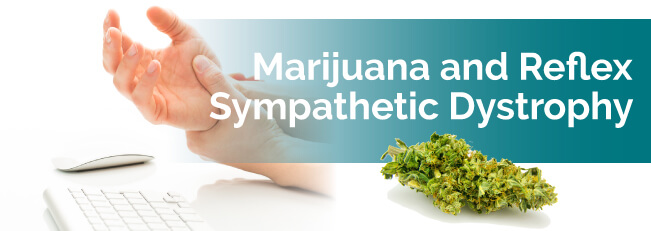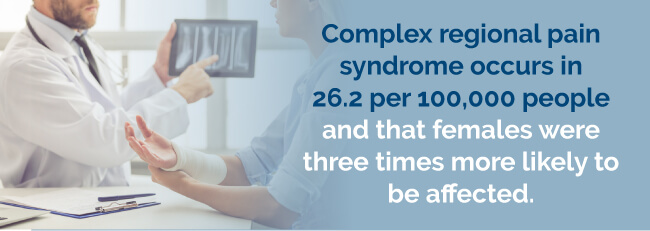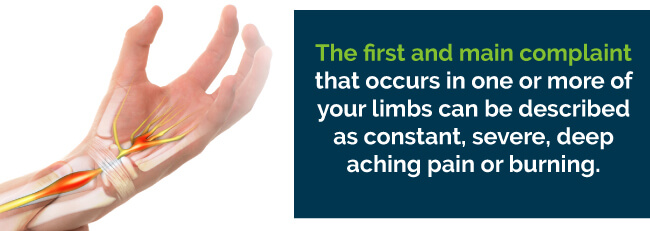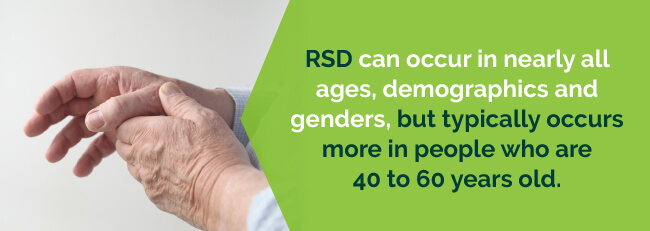
Medical marijuana has proven to be exceptionally helpful in treating the symptoms of reflex sympathetic dystrophy (RSD). Cannabinoid treatment can relieve the stress, depression and severe anxiety often brought on as a result of the disease. Additionally, medical marijuana can be utilized to assist patients with immediate pain relief, reducing muscle sensitivity and chronic pain. Patient testimonials have demonstrated significant, fast relief from symptoms associated with reflex sympathetic dystrophy.
Patients who have reflex sympathetic dystrophy describe symptoms including:
There are several other symptoms associated with RSD, but these are the most common.
The sympathetic nervous system is responsible for regulating involuntary functions of the body such as increased blood pressure and heart rate and constricting blood vessels. It is the abnormal responses that are said to cause the chronic pain associated with RSD. RSD often begins with burning pain present in the arms, fingers, palms of hands and/or shoulders. This condition is easily misdiagnosed as a painful nerve injury. In turn, the skin covering the affected areas will often become extremely sensitive, swollen and inflamed.
Although the exact cause of RSD is unknown, it is believed to develop as a result of direct injury to the nerves, surgery, trauma, infection, atherosclerotic cardiovascular disease or radiation therapy. Though it often begins as centralized in one part of the body, 92% of patients have reported a spread of the disease, and 35% of patients have reported symptoms throughout their whole body.
Complex regional pain syndrome (CRPS) has been classified and divided into two groups dependent on the resulting nerve lesions following the injury:
You may have developed reflex sympathetic dystrophy as a result of a forceful trauma to your leg or arm, for example, as a result of a fracture, crushed limb injury or amputation. A sprained ankle, infection, heart attack or surgery can also lead to developing RSD, as can emotional stress. Researchers don’t understand how these types of traumas or injuries can trigger reflex sympathetic dystrophy, but it might be because of inappropriate inflammatory reactions and a dysfunctional relationship between your peripheral and central nervous system.
This condition was initially considered by Claude Bernard et al. in the mid-1800s. Back then, it was known as complex regional pain syndrome, a term that is still used today to describe the condition. During the Civil War, soldiers suffering from low-velocity injuries due to high-mass missiles developed what American physician and writer Silas Weir-Mitchell called causalgia, or neuropathic pain.
The term reflex sympathetic dystrophy came into use in the 1940s. There have been studies since that time, but today, researchers are still frustrated with this fairly rare condition due to not fully understanding the pathophysiology.
Although rare, CRPS is beginning to increase in diagnosis. While the exact prevalence of the disease is unknown, the International Association for the Study of Pain estimated that CRPS occurs in 26.2 per 100,000 people and that females were three times more likely to be affected by the condition than males.

The precise process of how RSD occurs is not understood completely. It’s thought to include abnormal excitation and irritation of nervous tissue that leads to abnormal nerve impulses affecting skin and blood vessels. The peripheral nerves, brain, and involuntary nervous system also seem to be involved.
There are some conditions and circumstances that can trigger RSD, including:
RSD symptoms most commonly affect your shoulder or arm and sometimes your hip or leg. Symptoms seem to come on gradually, often starting with discomfort, gradual stiffness, weakness or a burning sensation in the affected area. But occasionally, the symptoms can come on suddenly, consisting of severe pain, extreme sensitivity and stiffness of the affected area.
Intense, chronic pain is the key symptom of RSD and tends to get worse with time. Normally, it affects your hands or feet, legs or arms and is accompanied by:
These are the common symptoms of RSD. However, there are other symptoms you may experience as well such as depression.
Reflex sympathetic dystrophy can create many negative effects. The effects depend on the stage of RSD you have.
This stage can last several months. During this stage, you experience increased sensitivity to touch and burning pain. The pain with RSD is longer lasting and more constant than what you would expect with an injury. Joint stiffness and swelling typically follow, and your affected limb may increase in redness and warmth. You may also experience faster hair and nail growth than usual as well as profuse sweating.
This stage can last anywhere from three to 12 months. You’ll notice that your skin wrinkles disappear and you’ll experience more constant swelling. The temperature of your skin becomes cooler. Your pain is more widespread, nails become brittle and your stiffness increases. The affected area can also become more sensitive to touch.
After one year, you move to stage III. During this stage, the skin of the affected area affected becomes dry, pale, shiny and tightly stretched. The area is stiff, and there’s little hope of regaining motion in it. The condition may spread to other body areas, and your pain may decrease.
Common RSD effects include:
Out-of-proportion pain and mobility problems are the main characteristics of RSD. The first and main complaint that occurs in one or more of your limbs can be described as constant, severe, deep aching pain or burning.

You will likely experience painful tactile stimulation of your skin with things like a light breeze or clothing increasing the sensation. Repetitive tactile stimulation such as tapping on your skin can cause increased pain with each tap. When you stop the repetitive stimulation, you may feel a prolonged pain sensation afterward known as hyperpathia.
RSD patients have trouble moving because it causes them pain. Their muscle contraction is interrupted and described as being hard to initiate movement, like they have “stiff” joints.
You may experience a decrease in extremity mobilization, which can result in disuse atrophy or wasting of muscles. You may initially experience pain. However, many patients report experiencing a lot of stiffness and inability to initiate movement.
Involuntary jerking and tremors of your extremities may occur. Psychological stress worsens these symptoms. You may have severe muscle spasms that come on suddenly and can leave you incapacitated.
Research data from the National Institute of Neurological Disorders and Stroke (NINDS) found that approximately 12 to 21 percent of patients developed RSD after experiencing hemiplegia, or paralysis of one side of the body.
RSD occurs in two to five percent of patients as a complication with peripheral nerve injury, according to NINDS. The peripheral nerves connect your brain and spinal cord to other body parts, including your muscles and skin.

Millions of U.S. residents may experience RSD’s debilitating symptoms. RSD can occur in nearly all ages, demographics and genders, but typically occurs more in people who are 40 to 60 years old, research suggests.
There is no standard RSD treatment. However, early treatment of symptoms and prevention of the condition are recommended. Often, the earlier you receive treatment, the more effective it is.
Unless instructed otherwise by your physician, you should begin daily physical therapy as soon as you receive an RSD diagnosis. Paraffin wax and whirlpool baths can be helpful for maintaining mobility. Heat or ice applications are not a good idea since they could overstimulate your nerve endings and lead to more discomfort. Putting a splint on the affected area — particularly the hand — while you’re resting can help prevent contractures, or muscle contraction deformities.
TENS is a special device that helps treat the earlier stages of RSD. Your doctor can add TENS treatment to other therapy programs. This device alters your nerve transmissions, helping with pain by blocking the nerve impulses. It’s a fairly inexpensive treatment option that patients seem to tolerate well with little side effects.
Systemic or local glucocorticosteroid drugs such as prednisone can effectively treat some RSD cases. With lower doses of these drugs, side effects are rare, but some side effects that are possible include:
Analgesics and nonsteroidal anti-inflammatory drugs can relieve pain. Your doctor may also prescribe muscle relaxants. These drugs may cause stomach ulcers if you take them excessively.
Some RSD patients can receive medications that block nerve function like:
Sympathetic blockade is a specialized procedure that’s often helpful for treating the pain with RSD. This treatment should be performed in the early stages of the condition to provide better pain relief.
There are side effects to both nerve blocks and the sympathetic blockade, including:
Nerve blocks can’t always be used. If you’re experiencing pain that’s not in a single or small group of nerves, this treatment might not be beneficial for you.
This procedure is used if the blockade procedure is ineffective. There are risks associated with this procedure, and they’re typically greater than the risks of a chemical sympathectomy. You can discuss these risks with your doctor.
Medical marijuana for reflex sympathetic dystrophy can be substantially less expensive than pharmaceutical pain relievers. Cannabis also doesn’t come with the risky side effects that are associated with pain medications like liver damage, stomach bleeding and kidney damage.
Marijuana for reflex sympathetic dystrophy is found at cannabis dispensaries at far less than the cost of pharmaceutical drugs. Since 1975, weed has been used as a natural and effective way of relieving most chronic pain with no harmful effects to the body.
Cannabis for reflex sympathetic dystrophy also helps ease psychological problems associated with RSD. Healthy use of medical pot can overcome psychological concerns such as depression and suicidal thoughts. Medical weed also eases both emotional and physical stress, which are two huge causes of heightened pain in RSD. Medical marijuana may even help you lessen your RSD symptoms enough to get back to a normal, social functioning life.
Cannabis can offer relief for RSD without psychoactive side effects. Strains of weed high in Cannabidiol (CBD) — even in the form of oils, edibles and tinctures — are beneficial in treating:
You can also use topical lotions to loosen your stiff joints and relieve pain. Cannabinol (CBN)-rich products help relieve nerve pain, muscle spasms and convulsions. You may get a mild sedative effect, which is perfect if you’re struggling with insomnia. There are also antidepressant qualities in CBN called “natural aspirin,” although it’s much stronger.
If you’re struggling with insomnia, you may benefit from heavier indica strains since they’re high in Tetrahydrocannabinol (THC) and have more a sedative effect than sativa strains. Indica strains are also good for treating stress, anxiety and pain.
Sativa strains are also high in THC, but they produce a more uplifting and energetic experience. They can be helpful if you’re suffering from depression or don’t have much of an appetite anymore. These strains are better in the daytime.
Various medical marijuana strains have different medicinal properties for reflex sympathetic dystrophy.
Pain is a common characteristic of RSD, and cannabis is very helpful in treating pain. Research is starting to find that cannabis may interact with your pain-signaling cells, and the CBD and THC in weed interact with your other body pain systems and even work as an inflammatory.
There are many types of pain that weed can ease including muscle spasms or cramps, joint pain, muscle pain and inflammatory pain. These are all associated with RSD.
As mentioned above, there are various ways to reap the benefits of medical cannabis for reflex sympathetic dystrophy. Two popular ways to get the medicinal pain properties from weed are smoking it and eating it. This all depends on your preference. There are differences between the two and the experience you’ll receive, but this doesn’t mean one way is better than the other.

Edibles taste good and come in many forms. The effects come on more gradually and give you a steady body high. Again, it’s your choice— all forms help ease your RSD symptoms just the same.
Strains for pain include:
Anti-inflammatory strains include:
Strains for muscle spasms include:
Since reflex sympathetic dystrophy and its symptoms can bring anyone down, you may want to check into cannabis strains that are great for your overall well-being. These strains can treat anything from aches and pains and loss of appetite to depression and insomnia. Some good choices include:
There are many medical cannabis strains available from dispensaries today, and all have different therapeutic effects. If you’re unsure which ones could work for you, search for and consult with a medical marijuana dispensary or doctor through MarijuanaDoctors.com. We aim to help you improve your quality of life and symptoms of reflex sympathetic dystrophy.
Looking for more information about CRPS I, CRPS II, Causalgia, or Reflex Sympathetic Dystrophy? Check out our additional resources below:
Find A Doctor Find A Dispensary